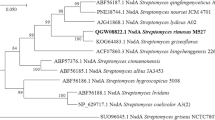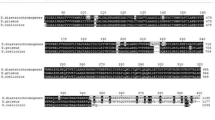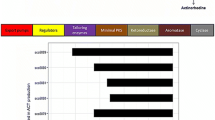Abstract
Streptomycetes naturally produce a variety of secondary metabolites, in the process of physiological differentiation. Streptomyces venezuelae differentiates into spores in liquid media, serving as a good model system for differentiation and a host for exogenous gene expression. Here, we report the growth and differentiation properties of S. venezuelae ATCC-15439 in liquid medium, which produces pikromycin, along with genome-wide gene expression profile. Comparison of growth properties on two media (SPA, MYM) revealed that the stationary phase cell viability rapidly decreased in SPA. Submerged spores showed partial resistance to lysozyme and heat, similar to what has been observed for better-characterized S. venezuelae ATCC10712, a chloramphenicol producer. TEM revealed that the differentiated cells in the submerged culture showed larger cell size, thinner cell wall than the aerial spores. We analyzed transcriptome profiles of cells grown in liquid MYM at various growth phases. During transition and/or stationary phases, many differentiationrelated genes were well expressed as judged by RNA level, except some genes forming hydrophobic coats in aerial mycelium. Since submerged spores showed thin cell wall and partial resistance to stresses, we examined cellular expression of MreB protein, an actin-like protein known to be required for spore wall synthesis in Streptomycetes. In contrast to aerial spores where MreB was localized in septa and spore cell wall, submerged spores showed no detectable signal. Therefore, even though the mreB transcripts are abundant in liquid medium, its protein level and/or its interaction with spore wall synthetic complex appear impaired, causing thinner- walled and less sturdy spores in liquid culture.
Similar content being viewed by others
References
Bibb, M.J., Domonkos, A., Chandra, G., and Buttner, M.J. 2012. Expression of the chaplin and rodlin hydrophobic sheath proteins in Streptomyces venezuelae is controlled by σBldN and a cognate anti-sigma factor, RsbN. Mol. Microbiol. 84, 1033–1049.
Davies, J. 2013. Specialized microbial metabolites: functions and origins. J. Antibiot. 66, 361–364.
Daza, A., Martin, J.F., Dominguez, A., and Gil, J.A. 1989. Sporulation of several species of Streptomyces in submerged cultures after nutritional downshift. Microbiology 135, 2483–2491.
Donczew, M., Mackiewicz, P., Wrobel, A., Flardh, K., Zakrzewska-Czerwinska, J., and Jakimowicz, D. 2016. ParA and ParB coordinate chromosome segregation with cell elongation and division during Streptomyces sporulation. Open Biol. 6, 150263.
Doull, J.L., Singh, A.K., Hoare, M., and Ayer, S.W. 1993. Production of a novel polyketide antibiotic, jadomycin B, by Streptomyces venezuelae following heat shock. J. Antibiot. 46, 869–871.
Elliot, M.A., Karoonuthaisiri, N., Huang, J., Bibb, M.J., Cohen, S.N., Kao, C.M., and Buttner, M.J. 2003. The chaplins: a family of hydrophobic cell-surface proteins involved in aerial mycelium formation in Streptomyces coelicolor. Genes Dev. 17, 1727–1740.
Flärdh, K. and Buttner, M.J. 2009. Streptomyces morphogenetics: dissecting differentiation in a filamentous bacterium. Nat. Rev. Microbiol. 7, 36–49.
Glazebrook, M.A., Doull, J.L., Stuttard, C., and Vining, L.C. 1990. Sporulation of Streptomyces venezuelae in submerged cultures. J. Gen. Microbiol. 136, 581–588.
Grantcharova, N., Lustig, U., and Flärdh, K. 2005. Dynamics of FtsZ assembly during sporulation in Streptomyces coelicolor A3 (2). J. Bacteriol. 87, 3227–3237.
Green, M.R. and Sambrook, J. 2012. Molecular cloning: a laboratory manual, 4th ed. Cold Spring Harbor Laboratory Press, New York, N.Y., USA.
He, J., Sundararajan, A., Devitt, N.P., Schilkey, F.D., Ramaraj, T., and Melançon, C.E. 2016. Complete genome sequence of Streptomyces venezuelae ATCC 15439, producer of the methymycin/ pikromycin family of macrolide antibiotics, using PacBio technology. Genome Announc. 4, e00337–16.
Hopwood, D.A. 2007. Streptomyces in nature and medicine: the antibiotic makers. Oxford University Press.
Jakimowicz, D. and van Wezel, G.P. 2012. Cell division and DNA segregation in Streptomyces: how to build a septum in the middle of nowhere? Mol. Microbiol. 85, 393–404.
Jung, W.S., Lee, S.K., Hong, J.S.J., Park, S.R., Jeong, S.J., Han, A.R., Sohng, J.K., Kim, B.G., Choi, C.Y., and Sherman, D.H. 2006. Heterologous expression of tylosin polyketide synthase and production of a hybrid bioactive macrolide in Streptomyces venezuelae. Appl. Microbiol. Biotechnol. 72, 763–769.
Kendrick, K.E. and Ensign, J.C. 1983. Sporulation of Streptomyces griseus in submerged culture. J. Bacteriol. 155, 357–366.
Kieser, T., Bibb, M., Buttner, M., Chater, K., and Hopwood, D. 2000. Practical Streptomyces genetics. The John Innes Foundation, Norwich, UK.
Kim, Y.M. and Kim, J.h. 2004. Formation and dispersion of mycelial pellets of Streptomyces coelicolor A3 (2). J. Microbiol. 42, 64–67.
Kim, E.J., Yang, I., and Yoon, Y.J. 2015. Developing Streptomyces venezuelae as a cell factory for the production of small molecules used in drug discovery. Arch. Pharm. Res. 38, 1606–1616.
Kittendorf, J.D. and Sherman, D.H. 2009. The methymycin/pikromycin pathway: A model for metabolic diversity in natural product biosynthesis. Bioorg. Med. Chem. 17, 2137–2146.
Kleinschnitz, E.M., Heichlinger, A., Schirner, K., Winkler, J., Latus, A., Maldener, I., Wohlleben, W., and Muth, G. 2011. Proteins encoded by the mre gene cluster in Streptomyces coelicolor A3 (2) cooperate in spore wall synthesis. Mol. Microbiol. 79, 1367–1379.
Lee, K.J. and Rho, Y.T. 1993. Characteristics of spores formed by surface and submerged cultures of Streptomyces albidoflavus SMF- 301. Microbiology 139, 3131–3137.
Manteca, A., Alvarez, R., Salazar, N., Yagüe, P., and Sanchez, J. 2008. Mycelium differentiation and antibiotic production in submerged cultures of Streptomyces coelicolor. Appl. Environ. Microbiol. 74, 3877–3886.
Mazza, P., Noens, E.E., Schirner, K., Grantcharova, N., Mommaas, A.M., Koerten, H.K., Muth, G., Flärdh, K., Van Wezel, G.P., and Wohlleben, W. 2006. MreB of Streptomyces coelicolor is not essential for vegetative growth but is required for the integrity of aerial hyphae and spores. Mol. Microbiol. 60, 838–852.
McCormick, J.R. and Flärdh, K. 2012. Signals and regulators that govern Streptomyces development. FEMS Microbiol. Rev. 36, 206–231.
Morris, J.K. 1965. A formaldehyde glutaraldehyde fixative of high osmolality for use in electron microscopy. J. Cell Biol. 27, 137.
Novella, I.S., Barbés, C., and Sánchez, J. 1992. Sporulation of Streptomyces antibioticus ETHZ 7451 in submerged culture. Can. J. Microbiol. 38, 769–773.
Rueda, B., Miguélez, E.M., Hardisson, C., and Manzanal, M.B. 2001. Mycelial differentiation and spore formation by Streptomyces brasiliensis in submerged culture. Can. J. Microbiol. 47, 1042–1047.
Santos-Beneit, F., Gu, J.Y., Stimming, U., and Errington, J. 2017. ylmD and ylmE genes are dispensable for growth, cross-wall formation and sporulation in Streptomyces venezuelae. Heliyon 3, e00459.
Schwedock, J., McCormick, J., Angert, E., Nodwell, J., and Losick, R. 1997. Assembly of the cell division protein FtsZ into ladderlike structures in the aerial hyphae of Streptomyces coelicolor. Mol. Microbiol. 25, 847–858.
Sigle, S., Ladwig, N., Wohlleben, W., and Muth, G. 2015. Synthesis of the spore envelope in the developmental life cycle of Streptomyces coelicolor. Int. J. Med. Microbiol. 305, 183–189.
Song, J.Y., Yoo, Y.J., Lim, S.K., Cha, S.H., Kim, J.E., Roe, J.H., Kim, J.F., and Yoon, Y.J. 2016. Complete genome sequence of Streptomyces venezuelae ATCC 15439, a promising cell factory for production of secondary metabolites. J. Biotechnol. 219, 57–58.
Stuttard, C. 1982. Temperate phages of Streptomyces venezuelae: lysogeny and host specificity shown by phages SV1 and SV2. Microbiology 128, 115–121.
van Dissel, D., Claessen, D., and van Wezel, G.P. 2014. Morphogenesis of Streptomyces in submerged cultures. Adv. Appl. Microbiol. 89, 1–45.
van Keulen, G. and Dyson, P.J. 2014. Production of specialized metabolites by Streptomyces coelicolor A3 (2). Adv. Appl. Microbiol. 89, 217–266.
van Wezel, G.P., Krabben, P., Traag, B.A., Keijser, B.J., Kerste, R., Vijgenboom, E., Heijnen, J.J., and Kraal, B. 2006. Unlocking Streptomyces spp. for use as sustainable industrial production platforms by morphological engineering. Appl. Environ. Microbiol. 72, 5283–5288.
van Wezel, G.P. and McDowall, K.J. 2011. The regulation of the secondary metabolism of Streptomyces: new links and experimental advances. Nat. Prod. Rep. 28, 1311–1333.
Wilson, D.J., Xue, Y., Reynolds, K.A., and Sherman, D.H. 2001. Characterization and analysis of the PikD regulatory factor in the pikromycin biosynthetic pathway of Streptomyces venezuelae. J. Bacteriol. 183, 3468–3475.
Xue, Y. and Sherman, D.H. 2001. Biosynthesis and combinatorial biosynthesis of pikromycin-related macrolides in Streptomyces venezuelae. Metab. Eng. 3, 15–26.
Yi, J.S., Kim, M., Kim, E.J., and Kim, B.G. 2018. Production of pikromycin using branched chain amino acid catabolism in Streptomyces venezuelae ATCC 15439. J. Ind. Microbiol. Biotechnol. 45, 293–303.
Yin, P., Wang, Y.H., Zhang, S.L., Chu, J., Zhuang, Y.P., Chen, N., Li, X.F., and Wu, Y.B. 2008. Effect of mycelial morphology on bioreactor performance and avermectin production of Streptomyces avermitilis in submerged cultivations. J. Chinese Inst. Chem. Eng. 39, 609–615.
Yoon, Y.J., Beck, B.J., Kim, B.S., Kang, H.Y., Reynolds, K.A., and Sherman, D.H. 2002. Generation of multiple bioactive macrolides by hybrid modular polyketide synthases in Streptomyces venezuelae. Chem. Biol. 9, 203–214.
Yoon, S.H., Ha, S.M., Lim, J., Kwon, S., and Chun, J. 2017. A largescale evaluation of algorithms to calculate average nucleotide identity. Antonie van Leeuwenhoek 110, 1281–1286.
Author information
Authors and Affiliations
Corresponding author
Rights and permissions
About this article
Cite this article
Kim, JE., Choi, JS. & Roe, JH. Growth and differentiation properties of pikromycin-producing Streptomyces venezuelae ATCC15439. J Microbiol. 57, 388–395 (2019). https://doi.org/10.1007/s12275-019-8539-3
Received:
Revised:
Accepted:
Published:
Issue Date:
DOI: https://doi.org/10.1007/s12275-019-8539-3




